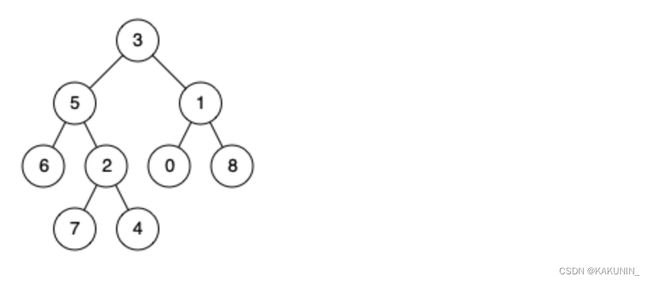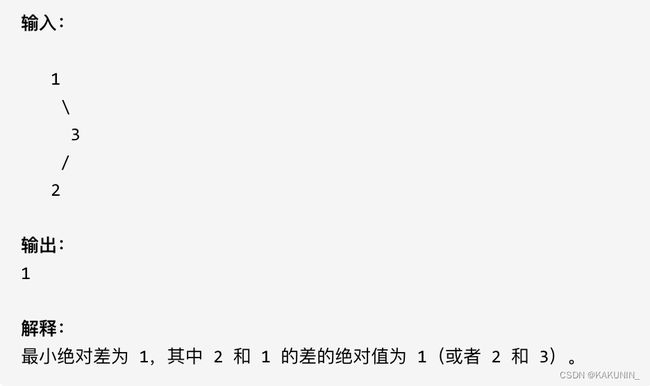代码随想录【Day21】| 530. 二叉搜索树的最小绝对差、501. 二叉搜索树中的众数、236. 二叉树的最近公共祖先
530. 二叉搜索树的最小绝对差
题目链接
题目描述:
给你一棵所有节点为非负值的二叉搜索树,请你计算树中任意两节点的差的绝对值的最小值。
难点:
解答错误!仅考虑了相邻,漏掉了不相邻的情况(与根节点之差!)
class Solution {
public int getMinimumDifference(TreeNode root) {
//最小差值一定是相邻接的节点,子树某个根节点和左(右)孩子
//采用中序遍历就可以
if (root == null) return Integer.MAX_VALUE;
int left, right;
if (root.left != null) {
left = Math.min(getMinimumDifference(root.left), root.val - root.left.val);
}else {
left = Integer.MAX_VALUE;
}
if (root.right != null) {
right = Math.min(getMinimumDifference(root.right), root.right.val - root.val);
}else {
right = Integer.MAX_VALUE;
}
return Math.min(left, right);
}
}
在中序遍历中,要记录上一个遍历的节点!
class Solution {
TreeNode pre;
int result = Integer.MAX_VALUE;
public int getMinimumDifference(TreeNode root) {
//采用中序遍历
traversal(root);
return result;
}
private void traversal(TreeNode root) {
if (root == null) return;
traversal(root.left);
if (pre != null) {
result = Math.min(result, root.val - pre.val);
}
pre = root;
traversal(root.right);
}
}
时长:
15min
收获:
中序遍历,记录上一个遍历的节点
501. 二叉搜索树中的众数
题目链接
题目描述:
给定一个有相同值的二叉搜索树(BST),找出 BST 中的所有众数(出现频率最高的元素)。
假定 BST 有如下定义:
结点左子树中所含结点的值小于等于当前结点的值
结点右子树中所含结点的值大于等于当前结点的值
左子树和右子树都是二叉搜索树
例如:
提示:如果众数超过1个,不需考虑输出顺序
进阶:你可以不使用额外的空间吗?(假设由递归产生的隐式调用栈的开销不被计算在内)
难点:
思路:
时间复杂度:O()
空间复杂度:O()
class Solution {
int cnt;
int maxNum;
TreeNode pre;
List<Integer> result = new ArrayList<>();
public int[] findMode(TreeNode root) {
searchBST(root);
return result.stream().mapToInt(Integer::intValue).toArray();
}
private void searchBST(TreeNode root) {
if (root == null) return;
searchBST(root.left);
if (pre == null) { //第一个节点
cnt = 1;
}else if(pre.val == root.val) { //相同值,计数
cnt++;
}else { //不同值,计数器重置1
cnt = 1;
}
pre = root;
if (cnt == maxNum) {
result.add(root.val);
}
if (cnt > maxNum) {
result.clear();
result.add(root.val);
maxNum = cnt;
}
searchBST(root.right);
}
}
时长:
22min
收获:
使用双指针,记录上一个遍历的节点
将ArrayList< Integer >转化为int[]数组的方式:
result.stream().mapToInt(Integer::intValue).toArray();
236. 二叉树的最近公共祖先
题目链接
题目描述:
给定一个二叉树, 找到该树中两个指定节点的最近公共祖先。
百度百科中最近公共祖先的定义为:“对于有根树 T 的两个结点 p、q,最近公共祖先表示为一个结点 x,满足 x 是 p、q 的祖先且 x 的深度尽可能大(一个节点也可以是它自己的祖先)。”
例如,给定如下二叉树: root = [3,5,1,6,2,0,8,null,null,7,4]

示例 1: 输入: root = [3,5,1,6,2,0,8,null,null,7,4], p = 5, q = 1 输出: 3 解释: 节点 5 和节点 1 的最近公共祖先是节点 3。
示例 2: 输入: root = [3,5,1,6,2,0,8,null,null,7,4], p = 5, q = 4 输出: 5 解释: 节点 5 和节点 4 的最近公共祖先是节点 5。因为根据定义最近公共祖先节点可以为节点本身。
说明:
所有节点的值都是唯一的。
p、q 为不同节点且均存在于给定的二叉树中。
难点:
思路:
class Solution {
public TreeNode lowestCommonAncestor(TreeNode root, TreeNode p, TreeNode q) {
if (root == p || root == q || root == null) return root;
TreeNode left = lowestCommonAncestor(root.left, p, q);
TreeNode right = lowestCommonAncestor(root.right, p, q);
if (left != null && right != null) return root;
if (left == null && right != null) return right;
if (left != null && right == null) return left;
return null;
}
}
时长:
20min
收获:
有难度的一题,思路好好再捋一捋

